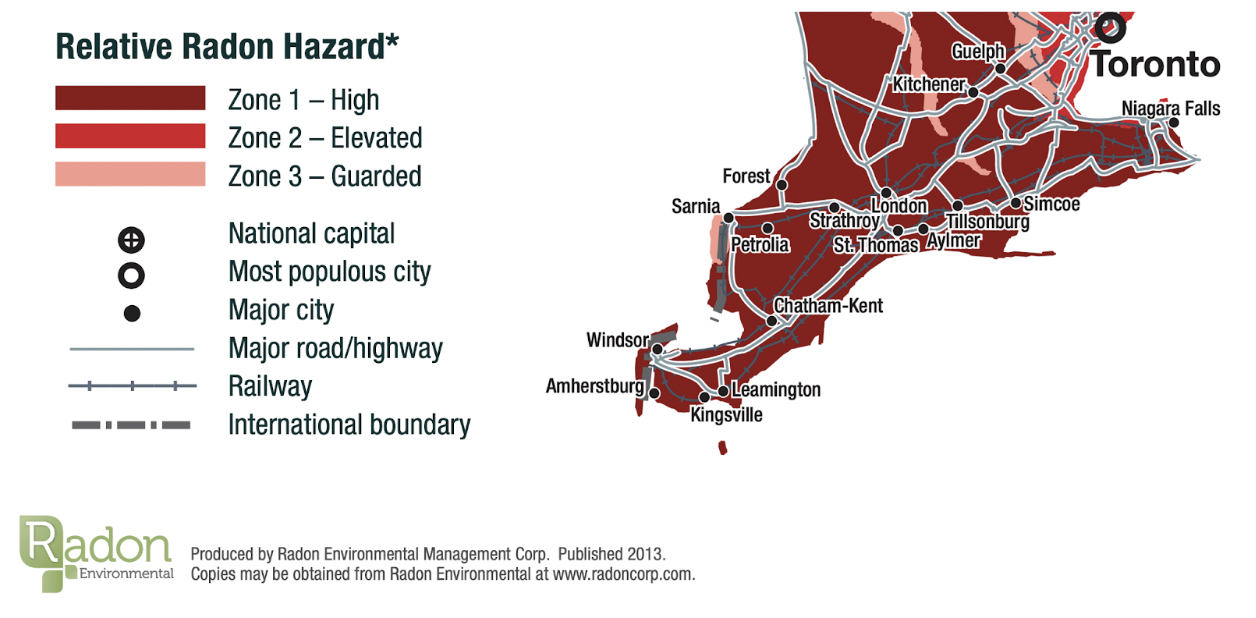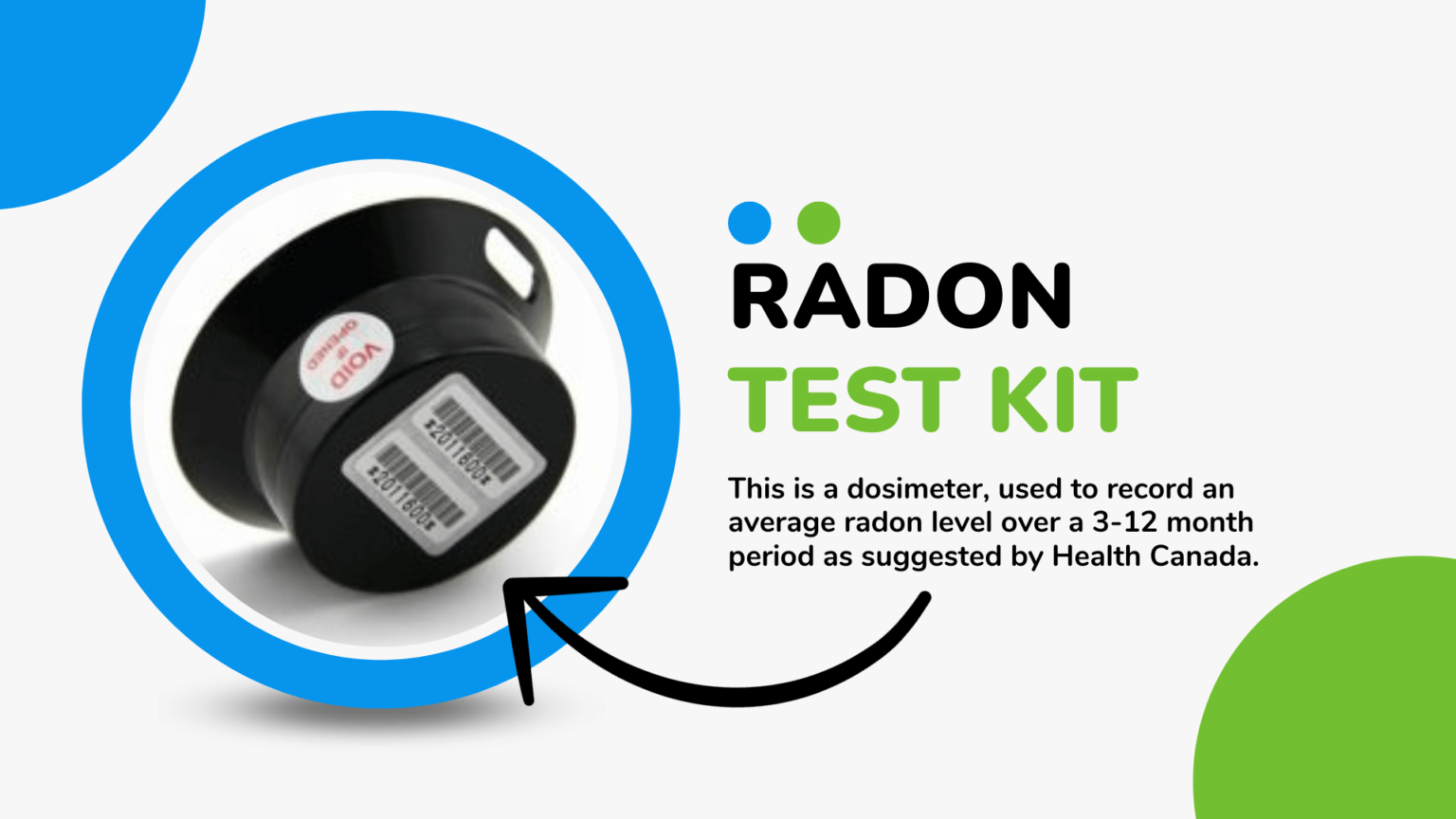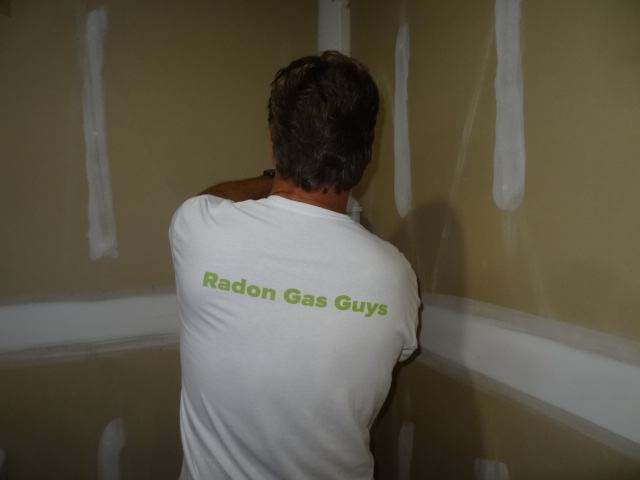Worried about radon gas in your home? If you’ve recently heard about radon gas, but aren’t quite sure what it is, how it can impact you and your family and how to find out if your home has high radon levels, you’re in the right place.
The guide will outline everything you need to know about radon gas in your home, including what radon gas is, radon gas exposure symptoms, how to test for it and what to do if your home has radon on it.
If you’d like to get started with a test kit right away or would like to chat with the professionals about radon gas exposure, give us a call at Radon Gas Guys. We would be happy to help answer any questions you may have about radon gas.
What is Radon Gas?
Radon gas is a colourless, odourless and tasteless gas. Sound similar? Although it is like carbon monoxide in that it is considered an indoor health hazard, radon gas impacts your health over the long term. Carbon monoxide can cause serious harm in a very short period of time. But radon gas creates health issues when it is breathed in over many years.
So, what is radon gas? Radon gas is a naturally occurring radioactive gas. It is found everywhere because it naturally occurs in the environment. When the heavy metal uranium decays within the earth, the decaying process releases a radioactive gas–that’s radon. Radon gas is generated within the earth and emitted from the ground, so the highest concentrations are usually found in basements, although any area of the home can be affected.
Just like carbon monoxide, because you can’t smell, see or taste radon gas, there won’t be any signs that high levels of radon gas are in your home. The only way you can determine if radon gas levels in your home are above average is if you conduct a radon gas test. This test must be done for a minimum of 91 days to get an accurate result.

Radon gas is naturally occurring and found everywhere in Ontario. When radon is outside, it won’t harm you as it will naturally disperse. However, radon does not really have anywhere to go inside your home. That’s when levels can build up and become dangerous.
Radon Gas Exposure Symptoms
As we mentioned above, there are some similarities between carbon monoxide and radon gas. However, there is a big difference: radon gas does not cause acute symptoms. This means that radon gas won’t make you feel sick or cause any physical symptoms right away. The biggest danger with radon gas is that prolonged exposure over time can significantly increase your risk of lung cancer.
In fact, radon gas exposure is the number one cause of lung cancer in non-smoking individuals. Radon gas is dangerous. This is especially true because you will have no way of knowing you’ve been exposed unless you conduct a test.
So, how exactly does radon gas cause lung cancer? When an individual breathes in radon gas, the gas decays into radioactive particles in the lungs. As the radioactive particles release energy in your body, that energy damages lung tissue.
Every time you breathe in radon, this process occurs. That’s why long-term exposure increases your chances–if you breathe in high levels of radon gas every day, your lungs will experience small amounts of damage every day…and this adds up over time.

Radon gas exposure does not have any symptoms. Unfortunately, the only symptoms associated with radon gas exposure are lung cancer symptoms. Symptoms of lung cancer include:
- Shortness of breath
- Difficulty breathing
- New or worsening cough
- Pain or tightness in chest
- Hoarseness
- Trouble swallowing
- Coughing blood
If you have noticed any of the symptoms above, talk to your doctor or healthcare provider right away. If you sleep in your basement or spend a significant portion of your daily life in the basement (for example, you have a basement office) and discover that you have high levels of radon gas, you may also want to talk to your doctor to see if you qualify for lung cancer screening.
Testing For Radon Gas
Everyone benefits from a radon gas test. Radon gas is found everywhere, but some areas have higher concentrations on average. This is because, as we mentioned above, radon gas is generated by decaying uranium. Depending on the amount of uranium in the soil and rock in your area, local levels may be higher or lower on average.
However, any home can have high levels of radon gas–even homes in areas where there is typically not as much uranium found. Every home is different. Radon enters your home from the lowest level, usually your basement. If your basement has foundation cracks or poor sealing around windows, sump pumps and hydro entries, radon may seep into your home.
Your neighbour’s home can have low levels of radon gas and your home can still test with high levels.
If you live in Canada, Health Canada conducted Canada-wide surveys between 2009 and 2011 to monitor the level of radon gas in the average home. This data was collected for cities across the nation. See the map below to find out the results of these surveys.

As you can see in the map above, most of Southern Ontario is in a “Zone 1 - High” area, meaning that there is a higher likelihood that your home will have elevated levels of radon gas. Other areas designed Zone 2 and Zone 1 are less likely to have elevated levels, but remember, each individual home should be tested to find out what your levels actually are.
Every home in Canada has some level of radon gas in it. Radon gas is naturally occurring and will seep into all homes. While there is no guaranteed safe level of radon gas exposure, the Canadian guideline for radon gas in the home is 200 Bq/m3.
If you conduct a test and find out your home has higher than the Canadian guideline, it is important to contact a radon gas mitigation company. But first, let’s talk about testing.
How To Test For Radon Gas In Your Home
You won’t be able to rely on noticeable health symptoms to determine if radon gas is in your home. Unlike carbon monoxide, there isn’t a detector that will go off if levels reach a certain point. You also won’t be able to see or smell anything, like you may notice with mould growth.
In order to test for radon gas, you need to purchase a radon test kit. You simply plug in a small device called a dosimeter in your basement or in the lowest level of the home that you spend at least 3-4 hours. Then, you forget about it! You must leave the test plugged in for at least three months (91 days). The dosimeter will measure the radon gas levels in your home’s air and provide an average at the end of the test period.

You can buy a test kit online and install it yourself. You can also contact a professional radon mitigation company to do it for you. Some homeowners prefer to work with radon mitigation professionals because then they know everything has been installed correctly. You wouldn’t want to get to the end of the three-month testing period just to discover the dosimeter was not installed correctly–you would then have to restart the process!
Radon Gas Testing Options
At Radon Gas Guys, it’s important to us that you are completely confident and satisfied from start to finish, and that includes during the testing process. We offer a variety of testing options and provide information on the different testing kits and monitors that are available to you so that you can choose the solution that works best for you and your family.

If you are concerned about the air quality in your home, mould growth is also a significant indoor health hazard. Many homeowners prefer to test for both radon and mould at the same time as it saves money and of course, time. Plus, it helps give you peace of mind!
Take a look at the testing options offered by the Radon Gas Guys below. Here, we have testing options for both a comprehensive air quality test package as well as different radon gas test kit options.
Comprehensive Test My Home Package
$425
Your one-stop shop for air quality testing! When you choose the Test My Home package, we will come to your home and test for both radon and mould. A radon test is conducted over the course of a few months to get the most accurate reading. Once complete, you will receive all your radon readings and a lab report for the mould results. If we find any problems, you’ll also receive a prescribed mitigation plan of action based on both reports.
$55 (refunded if Radon Gas Guys provide the mitigation system if needed)
Radon dosimeters are cost-effective and easy to use, making it a simple solution to find out if your home has excess levels of radon gas. Installed in the lowest level of your home or building, the dosimeter records an average radon level over a 3-12 month period, as outlined by Health Canada. Following the minimum 91-day test, homeowners must then send the results to a lab for analysis and results.
For more testing options, click here.
What To Do If Radon Gas Is Found In Your Home: Radon Mitigation Service
After you conduct a radon gas test in your home, you will receive results within 3-12 months depending on the test period. If it is found that you have high levels of radon gas, the next step is to work with the professionals to install a radon mitigation system.

When you work with Radon Gas Guys, you’ll be working with a team of trained and experienced professionals who not only help you get your radon gas levels under the national standard, but also make sure that your home is protected from whatever caused those high levels in the first place.
Here’s what you can expect when you work with us for radon gas mitigation:
- After the radon gas test is complete, we’ll determine a plan to resolve the problem if one is found
- Before the mitigation system is installed, our team will inspect your home to look for any areas where radon gas may be entering your home (for example, this could include cracks in the foundation, gaps around openings like windows, or areas around sump pumps and hydro entries)
- Our team will expertly seal up any areas that may be causing the problem or fix areas that could be letting excess radon gas in
- Finally, we’ll install our radon gas mitigation system
A lot of homeowners are surprised to find out that the radon gas mitigation system is actually quite a simple system. It consists of a pipe and a fan. This system is installed in the foundation of your house and it works by essentially sucking out radon gas and exhausting it outdoors. Although the process is complex and must be done by experienced professionals, it is actually not very invasive.
We are done within the day so it causes little disruption to your daily life and you have peace of mind knowing that your home has safe levels of radon right away! We also provide a 100% guarantee that our radon mitigation system will work to lower radon levels to below the Canadian standard. If it doesn’t work, we will correct the problem at no cost or refund you your money. We stand behind our work and it is of the utmost importance to us that you feel comfortable throughout the whole process!
Worried About Radon Gas In Your Home? Rely on Radon Gas Guys From Testing To Mitigation!
Learning about radon gas can feel a bit overwhelming, especially if you are only just hearing about it now. At the Radon Gas Guys, we want to help you feel comfortable during the entire process. We are committed to the health and safety of homeowners in Southern Ontario. We want to help you and your family stay safe in your home with effective radon removal services.
If you are worried about high levels of radon gas in your home and are ready for radon gas removal, give us a call. We would be happy to discuss your options and get a plan in place to reduce the high levels that could make you and your family sick.
My radon levels averaged around 100 bq/m3 but I spend a lot of time in the basement with my kids and felt that I needed to do something to reduce the levels. Called Rick and he was great to deal with. Explained everything, gave us a fair price and did a fantastic job. 100% recommend, my levels dropped significantly.
